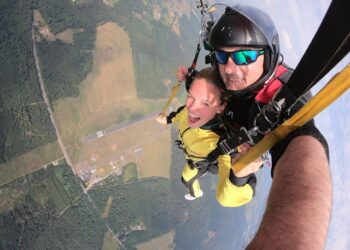Hang glide vs paraglide, learn how these two aerial sports compare in gear, control, risk, portability, and which one’s right for you.
If you’ve ever stood on a mountaintop and watched someone soar through the air, chances are you’ve seen a hang glider or paraglider dancing with gravity. Both sports offer freedom, adrenaline, and stunning views, but they’re not created equal.
Ask a hang glider and they’ll say their wing is faster, sleeker, and purer. Ask a paraglider and they’ll say their flight is smoother, more accessible, and more meditative, and also have some age limits. So who’s right?
Let’s unpack the differences, not just in shape, but in spirit, setup, control, and who each sport is truly for.
What You'll Discover:
What Is Hang Gliding?
Hang gliding uses a rigid, triangular wing frame, often made of aluminum and synthetic sailcloth. The pilot is suspended in a horizontal position from a harness and controls the flight by shifting body weight.
- Speeds: 20–60 mph
- Altitude: Often launched from hills or towed into the sky
- Control: More aerodynamic, less forgiving
- Vibe: Fast, daring, almost bird-like
What Is Paragliding?
Paragliding uses a soft, fabric wing (called a canopy) without a rigid frame. The pilot sits in a harness below the inflated wing, controlling direction and lift using brake toggles and risers.
- Speeds: 15–30 mph
- Altitude: Launched from hills, cliffs, or towed
- Control: Slower but more responsive to brake input
- Vibe: Relaxed, floaty, almost meditative
Hang Glide vs Paraglide at a Glance
| Feature | Hang Gliding | Paragliding |
| Wing Structure | Rigid metal + sailcloth | Inflatable fabric canopy |
| Pilot Position | Horizontal | Seated |
| Speed | Faster (20–60 mph) | Slower (15–30 mph) |
| Control | Weight shift | Brake toggles |
| Setup Time | Longer (20–40 min) | Quick (10–15 min) |
| Portability | Bulky (requires vehicle/rack) | Compact (fits in backpack) |
| Launch Options | Hills, tows, winches | Hills, tows, thermal lifts |
| Landing Skill | Requires precision | More forgiving |
| Learning Curve | Steeper | Smoother for beginners |
| Thrill Level | Higher adrenaline | Gentler flight style |
Gear Comparison: Wing to Wing
Hang Glider Gear:
- Rigid wing (30–40 lbs)
- Horizontal harness
- Helmet, gloves, flight suit
- Transport van or rooftop rack required
Paraglider Gear:
- Inflatable canopy (15–20 lbs)
- Backpack-stored harness
- Reserve parachute
- Lightweight helmet + gloves
Takeaway: Paragliding wins for portability. You can literally hike a mountain and fly down with gear on your back. Hang gliding? You’ll need a car, a roof rack, and possibly a second person.
Launching and Landing: What’s Easier?
Hang Gliding
Launch: Requires a running start from an incline. You’ll feel like you’re sprinting with a kite strapped to your chest.
Landing: Needs space and technique. Misjudging speed or angle can lead to crashes or gear damage.
Paragliding
Launch: Pull the canopy up, feel it inflate above you, and walk/run off a slope. Much less intimidating.
Landing: Slower descent makes it easier for beginners. Most landings are like stepping off a curb.
Speed, Range, and Altitude
Hang Gliding:
- Longer range per flight
- Higher max speeds
- Can cover up to 100+ miles in a single thermal-lift day
Paragliding:
- Shorter flights unless using thermal currents
- Slower, but easier to stay aloft for hours
- Preferred for soaring and ridge gliding
Verdict: If you want to go fast and far, hang gliding wins. If you want to stay up and enjoy the view, paragliding is your pick.
Risk and Safety Factors
Let’s be honest, both sports have real risks. But how they handle danger differs.
Hang Gliding
- Faster speed = harder crashes
- Less forgiving with control errors
- More resistant to sudden wind shifts
Paragliding
- More sensitive to turbulence and thermal collapse
- Easier to stall or spin with wrong input
- But lower speeds = less impact force
Bottom Line: Both sports require training and respect. Paragliding has more minor incidents, while hang gliding carries higher consequences for mistakes.
Which One’s Easier to Learn?
Paragliding is hands-down easier for beginners. You’ll get off the ground on Day 1 of most lessons. Instructors often start you on gentle slopes, gradually building confidence and control.
Hang gliding takes more strength, coordination, and mental processing. It may take several lessons just to launch safely, let alone soar.
Costs: Training and Gear Breakdown
| Item | Hang Gliding | Paragliding |
| Training Course | $1,500–$3,000 | $1,200–$2,500 |
| Wing + Gear | $3,000–$7,000 | $2,000–$5,000 |
| Replacement Wing | $3,000+ | $2,000+ |
| Certification (optional) | $100–$300 | $100–$300 |
Ongoing costs include inspections, travel to launch sites, and occasional repairs. Paragliding wins on entry-level affordability and gear portability.
Tandem Flights: Which Feels Better?
If you’re not ready to commit, try a tandem ride.
- Tandem paragliding is more common worldwide, especially in tourist mountain towns. It feels like floating.
- Tandem hang gliding is rarer but offers more intense speed and wind. Great for adrenaline seekers.
Which One Is Safer for Casual Flyers?
Paragliding, generally.
The lower speed, gentler launch, and backpack-sized gear make it ideal for weekend warriors and scenic adventurers.
That said, hang gliding is incredibly safe when done right, but mistakes can carry higher penalties due to speed and glide ratio.
Who Should Choose Hang Gliding?
You might love hang gliding if you:
- Love speed and precision
- Want to cover long distances in a single flight
- Are drawn to the idea of real flight, like birds or jets
- Don’t mind a tougher learning curve
- Have the physical strength and transportation for the gear
Who Should Choose Paragliding?
Paragliding is probably your best bet if you:
- Want something meditative and flowing
- Value portability and hiking-access flying
- Are new to aerial sports
- Don’t want to invest thousands right away
- Like the idea of floating with the air, not racing against it
Key Takings
- Hang gliding uses a rigid wing and offers higher speeds, longer ranges, and more intense flights, but with greater physical and gear demands.
- Paragliding uses a soft canopy, offering a slower, floatier, more accessible experience, ideal for beginners and casual adventurers.
- Paragliding is easier to learn, carry, and fly in more diverse locations.
- Hang gliding is for those who want speed, glide power, and a more technical challenge.
- Both sports come with risks, but paragliding is often considered more forgiving for new pilots.
- Cost, portability, and learning curve make paragliding more accessible, but hang gliding rewards those willing to train harder.
- Ultimately, the best sport is the one that fits your personality, goals, and sense of adventure.





